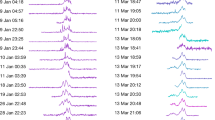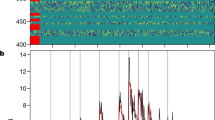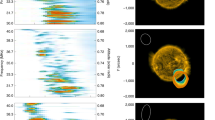Abstract
BETWEEN May 1972 and October 1974, observations were made from the University of Otago's field site at Swampy Summit near Dunedin, of Jupiter's high-frequency radio emissions. The frequency range of 23–25 MHz was reduced to a 2 MHz video signal, recorded on videotape, and analysed with a high resolution spectrum analyser to produce the dynamic spectrum of the millisecond radio bursts. The spectrum analyser was constructed from a modified video tape recorder, using the time expansion principle developed independently by Ellis1. The frequency and time resolution were 10 KHz and 500 µs, respectively, and the spectrum was recorded on 35 mm film at the rate of 20, 40 or 100 ms per half frame.
This is a preview of subscription content, access via your institution
Access options
Subscribe to this journal
Receive 51 print issues and online access
$199.00 per year
only $3.90 per issue
Buy this article
- Purchase on Springer Link
- Instant access to full article PDF
Prices may be subject to local taxes which are calculated during checkout
Similar content being viewed by others
References
Ellis, G. R. A., Aust. J. Phys., 26, 253 (1973).
Ellis, G. R. A., Nature, 235, 415 (1975).
Author information
Authors and Affiliations
Rights and permissions
About this article
Cite this article
GROTH, M., DOWDEN, R. Spectra of high-frequency radio emission from Jupiter. Nature 255, 382–384 (1975). https://doi.org/10.1038/255382a0
Received:
Accepted:
Issue Date:
DOI: https://doi.org/10.1038/255382a0
This article is cited by
-
Evolution of the spectral fine structure of Jupiter's decametric S-storms
Earth, Moon, and Planets (1991)
-
Variants of tilted-V events in Jupiter's decametric radio spectra
Earth, Moon, and Planets (1990)
-
A theory of Jovian shadow bursts
Earth, Moon, and Planets (1986)
-
Jovian S-burst observations at 32 MHz
Nature (1978)
-
S-bursts in Jupiter's decametric radio spectra
Astrophysics and Space Science (1977)
Comments
By submitting a comment you agree to abide by our Terms and Community Guidelines. If you find something abusive or that does not comply with our terms or guidelines please flag it as inappropriate.



